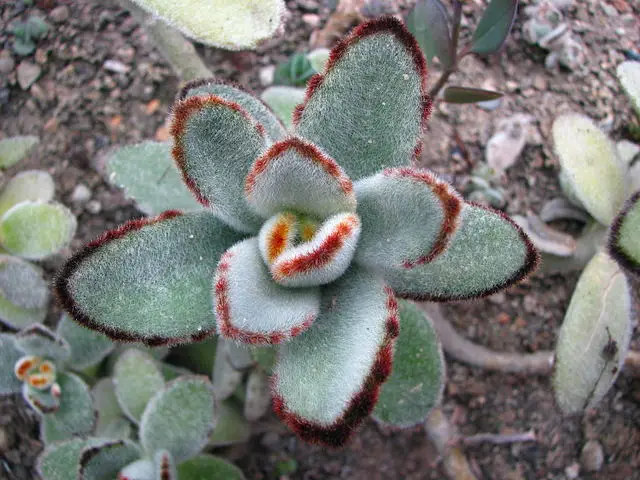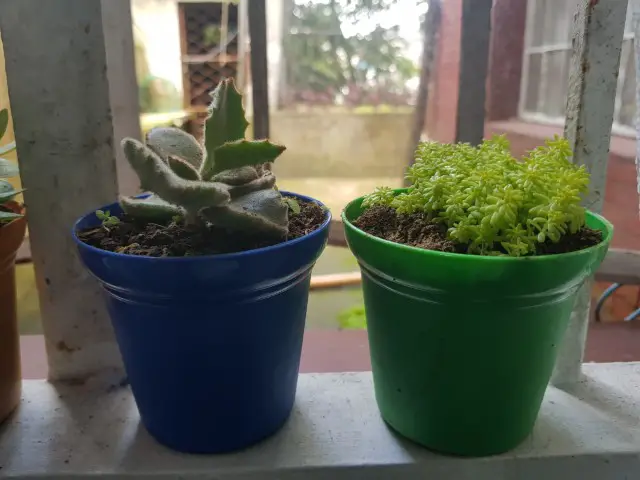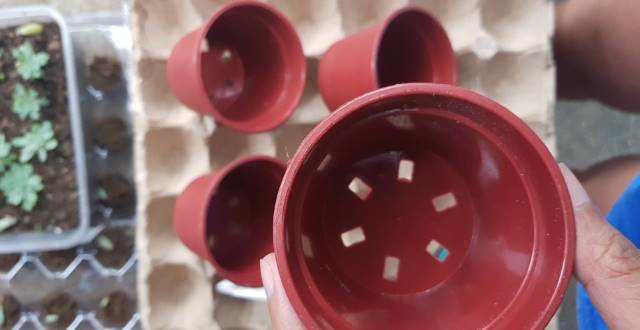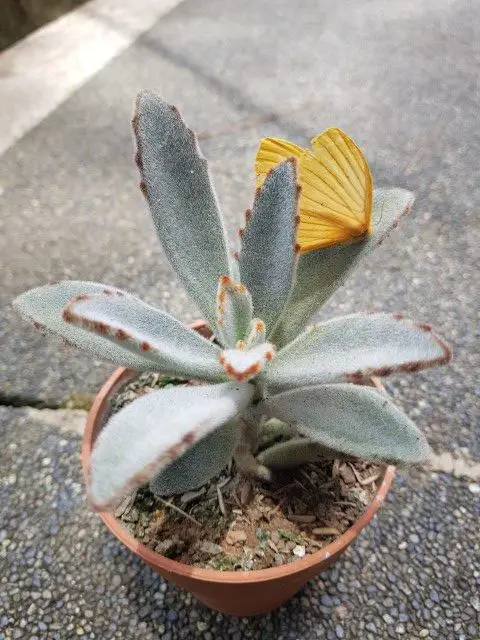Kalanchoe tomentosa a member of the Crassulaceae family is a wonderful perennial succulent. The term “tomentosa” means “covered with fine hairs” referring to the fuzzy Panda-like appearance of this plant. This is the reason it is popularly known as Panda Plant.
It is one of the 100 known varieties of Kalanchoe. Panda plant is a hardy shrub with a velvety texture and unusual foliage. It is commonly grown as a houseplant. Panda plant requires very low care and grows well indoors and outdoors making it a great choice for the novice gardeners. These plants are ideal for those people who lack a green thumb and cannot invest a lot of time in their management. Indoors they can be grown in containers and hanging baskets where they can easily trail down below the hanging baskets.
Origin and distribution
Kalanchoe tomentosa is native to the islands of Madagascar. It is now grown widely as an indoor and outdoor plant in many regions of the world. The original habitat of Panda plants is granite rocks. Like other succulents, it can survive in xerophytic (an environment where the water is very limited) conditions.
How does the Panda Plant look like?
The general appearance of this succulent is quite cute. It has an erect wordy stem, that grows up to 3.3 feet (100 cm) tall with an average height of 2 feet (61 cm).

It bears beautiful gray-green oval leaves with brownish-red spots on the margins. The brownish-red edges have white-silvery hairs, that typically resemble the fur of a panda bear. The other common names include Chocolate Soldier, Pussy Ears, Plush Plant, and Cocoon plant. Panda plant produces amazing tiny green, yellow, brown, or purple tubular-shaped flowers. It blooms rarely, but if you are lucky enough to get a chance to see the flowers, it blooms usually in the spring and summer seasons.
How to care for Kalanchoe tomentosa?
Panda plant has no special care requirements. It is a desert succulent and can be grown easily as a houseplant, and it will even thrive well when it remains neglected for quite a long time. The good news is that if you are planning a vacation or tour you do not need to worry about the care of your Panda plants.
Do you know how to care for your Panda Plants and make them grow healthy? Keep reading you will find a complete care guide and everything else you need to know about this amazing plant.
Location and sunlight requirements
The selection of an appropriate site is critical for the optimal growth of the plant. Kalanchoe tomentosa should be kept at a bright sunny location. Outdoors, keep your succulent at a location where they receive at least 6 hours of bright direct sunlight every day. When planting indoors, they must be kept near a sunny window, where they get ample sunlight during the daytime.

During spring and summer seasons move the Panda Plants outside but make sure to provide necessary protection from the intensely hot afternoon sun.
It is recommended to keep the plants away from direct sunlight throughout the day because exposure to intense light is damaging to the plant and can cause sunburn and tissue damage.
Outdoor planted Kalanchoe tomentosa can grow up to 24 inches tall. In indoor plants, the size of the plant is strictly dependent on the size of the pot in which it is planted.
So, if you want your Panda plants to grow tall better use large containers. Small containers will not provide enough space for root development.
Temperature and humidity requirements
For optimal growth of Panda plants, the preferred temperature range is 60° (15° C) to 75° F (23° C). Panda Plant is not cold hardy and it is suitable for growing in USDA Zone 9a to 11. It cannot be grown in lower zones where the temperature goes to low. These plants cannot survive frost or freezing temperatures. The succulents are also susceptible to excessively high temperatures. The lowest zone to grow Panda Plants in the US is USDA zone 9a where the temperature goes to a minimum of 20° F (-6.7° C).
USDA zones to grow Kalanchoe tomentosa
- USDA Zone 9a: (20-25 °F) -6.7 to -3.9 °C
- USDA Zone 9b: (25-30 °F) -3.9 to -1.1 °C
- USDA Zone 10a: (30-35 °F) -1.1 to 1.7 °C
- USDA Zone 10b: (35-40 °F) 1.7 to 4.4 °C
- USDA Zone 11a: (40-45 °F) 4.4 to 7.2 °C
- USDA Zone 11b: (45-50 °F) 7.2 to 10 °C
Humidity is not a big issue and the plants get enough humidity at room temperature. But Kalanchoe tomentosa is sensitive to high humidity, so avoid keeping these plants at a place that is too humid or damp.
Watering Kalanchoe tomentosa
Kalanchoe tomentosa is a perfect choice if you have a very tight work routine and often forget to water your plants. Panda Plant is quite a drought-tolerant and can go for several days without water.
Like many other succulents, the Panda plant has specific watering needs. It requires moderate watering and must not be watered frequently. The thick leaves and stems of the plants store water and allow it to survive for a considerably long time without water. The water stored in the leaves fulfills the water requirements of the plants when the water supply is short.
Watering is the most critical step for ensuring better health and growth of your plants. Panda plants should be watered using the “soak and dry” method. Give your plants a full drink of water and let the water drain out properly. Water until your soil becomes slightly moist.
Avoid too damp soil. Always let the soil dry before next watering and water only when the top 2 to 3 inches of the soil becomes dry. Do not overwater as it is highly damaging to Plant health and causes root rot. Always water the plants from the bottom to protect the leaves. Wet leaves will rot quickly, if you accidentally drop some water on the leaves, remove it as much as you can with a clean cloth or tissue paper.
Keep a vigilant eye on your plants to observe the signs of overwatering and underwatering. In most of the cases, underwatering is not a problem as the plants can go without water for several weeks or even months. But beyond a certain time limit your Panda plants will start showing the signs of underwatering. In such cases when the plants start showing the signs of underwatering simply resume watering to bring your plants to normal.
Leaves that have a yellow mushy appearance are an indication of overwatering. The roots usually rot due to excessive water around the root zone. As soon as you observe the first damaged leaf pluck it immediately and cut short the supply of water to let your plants recover soon. If your plant roots are completely damaged or decayed it will become impossible to recover the plants.
Soil or potting mix
It is recommended to use a standard succulent or cactus potting mixture for planting. It will keep your plants grow healthy and maintain the pH balance in the potting mix. The soil must be well-draining. A standard soil mix by adding a little more quantity of perlite will also work fine.
Fertilization
Kalanchoe tomentosa is a dessert succulent, it does not require to be fertilized like other plants. But if you want to fertilize your plants, it is recommended to apply a balanced dose of fertilizer once a month during spring and summer seasons and skip fertilization during the remaining year. A balanced liquid fertilizer of half-strength should be used for the fertilization of Panda plants.
Propagation Kalanchoe Panda
If you want to have more Panda Plants at your place, you can propagate the existing plant instead of buying new plants.
Propagating the indoor plants is a very easy and inexpensive method to get several new plants. Kalanchoe tomentosa can be propagated by leaf and stem cuttings.

Take a healthy leaf by gently twisting the leaf from the stem. Make sure you completely pull the leaf from the stem and no part of the leaf remains attached to the stem.
For propagation through stem cuttings take a 2 to 3 inches cutting for a healthy growing stem. The leaves or stems chosen for cuttings must be healthy with no signs of damage or pest attack.
Place the cuttings at a dry place and let them develop callous for 2 to 3 days. Then place the cuttings on a well-drained potting mix (a mix of sand, peat moss, and perlite). Keep sprinkling the water on the cuttings regularly several times a day. After a few weeks, new roots will start to develop from the cuttings. When the roots reach up to a length of 1 to 2 inches it is the right time to transfer your succulent into new pots.
Potting and Repotting
Gently pull the plant from the soil by digging the soil around the plant. Take clean pots and fill them with a standard cactus potting mix. Transfer the plants to the new pots. Once they are established provide the regular care as required by a full-grown mature Panda plant. It needs to be repotted every 2 years.

Once Panda plants get mature, they need to be repotted less frequently. You do not need a container bigger than 5 inches for repotting.
Pruning
Although Panda plants do not require frequent pruning, still if you want to maintain the shape of the plants keep them trimmed.
Pruning can help you to keep your panda plants short and dense. Always use clean sharp scissors or pruning shears to prune your plants well. Remove the long leaves or overgrowing plants parts and dead or decayed plant parts. This will create room for new and healthy growth.
Diseases or Insect Pests
Kalanchoe tomentosa is prone to mealybugs and root rot.
The soft-bodied mealybugs just love to feed on Panda plants. If a web-like white material appears on the leaves, it is an indication that the plant is attacked by mealybugs. The powdery white substance produced by mealybugs resembles the color of leaves of the plants. This is the reason they can easily camouflage on Panda plant leaves. Therefore, it is always hard to spot the mealybugs but if you have a closer look at the leaves you will be able to view them.
What to do if mealybugs attack your Panda plants?
Keep an eye on your plants and treat the infestation at an early stage as soon as you see the very first insect clinging on to the plants.
If the leaves are small and there are only a few mealybugs the most effective method to get rid of them is to manually remove the insects with a pin.

You can also use a recommended nontoxic pesticide to throw away these damaging insect pests. But it is better to use isopropyl alcohol (70%). Simply rub the leaves with alcohol and keep in observation for a few days until the insects are eliminated from the plants.
These plants are also attacked by root rot disease which is caused by fungi. Avoid overwatering to prevent root rot.
Is Kalanchoe tomentosa poisonous?
Almost all succulents are safe to humans, but they are toxic to animals such as cats, dogs, and livestock.
Once the animals feed on these plants or accidentally ingest any plant part they start to develop the symptoms of stomach pain, excessive salivation, change in heart rate and rhythm, vomiting, and diarrhea. In severe cases, it can cause the death of the animals.
If you are keeping pets at home, try to keep your plants away from your pets to avoid poisoning.
Bottom line
In conclusion, Kalanchoe tomentosa or Panda plants are beautiful succulents that are super easy to cultivate.
These plants will grow well with minimal care and even if they remain neglected for long. If you have a busy schedule and can’t spare enough time for caring for your plants, Kalanchoe tomentosa is a perfect choice for you.
Moreover, their Panda like appearance makes them very appealing to the children. You can use them at home and children’s room decorations.
It is obvious none of us would like to damage our plants. Just be careful not to expose your plants to high temperatures, overwatering, and insect pests as they will cause irreversible damage to your plants.
So just follow the right steps to care for your Kalanchoe tomentosa plants and enjoy the beauty of these amazing succulents.

